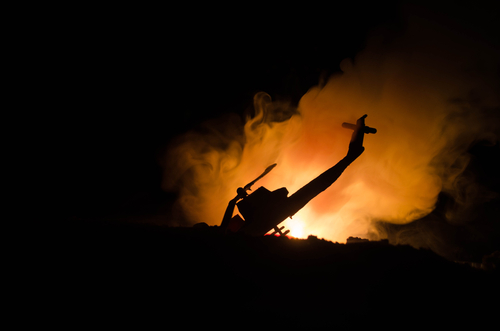
Seven Hindu pilgrims, including a two-year-old girl, perished in a fiery helicopter crash near Kedarnath after dense fog and treacherous weather conditions led to the fifth fatal incident on this route in just six weeks.
Key Takeaways
- A helicopter carrying Hindu pilgrims crashed in Uttarakhand, India, killing all seven people aboard, including a two-year-old girl, with preliminary findings suggesting “controlled flight into terrain” due to poor visibility.
- This marks the fifth helicopter crash on the Kedarnath pilgrimage route in just six weeks, resulting in a total of 13 fatalities and raising serious safety concerns about helicopter operations in the region.
- The crash occurred shortly after takeoff in dense fog conditions, with the helicopter last seen at 5:24 am before being reported missing at 6:13 am, prompting Chief Minister Pushkar Singh Dhami to suspend helicopter services and order a high-level inquiry.
- The incident follows a recent Air India disaster in Ahmedabad that killed 279 people, where a survivor reported flickering lights before the crash, adding to concerns about aviation safety standards in India.
- Regulatory authorities have suspended operations for Aryan Aviation pending investigation and have intensified safety oversight with live monitoring and surprise audits to prevent future tragedies.
Deadly Pattern of Helicopter Crashes Plagues Hindu Pilgrimage Route
The latest helicopter crash in India’s Himalayan region has claimed seven lives, including that of a two-year-old girl, continuing a disturbing pattern of aviation disasters in the area. The helicopter, operated by Aryan Aviation, departed from the sacred Hindu shrine of Kedarnath at 5:21 am on Friday and crashed just minutes later in the Rudraprayag district. Rescue teams faced significant challenges reaching the crash site, having to trek five kilometers through difficult terrain while battling dense fog and overcast conditions that severely limited visibility.
India’s civil aviation ministry has issued preliminary findings suggesting the cause was “controlled flight into terrain” due to the poor visibility conditions. This technical term indicates the pilot, despite having control of an airworthy aircraft, unintentionally flew into terrain – a tragic consequence of attempting to navigate through hazardous weather conditions. The victims included pilot Rajveer Singh Chauhan, a family from Maharashtra including the young child, two passengers from Uttar Pradesh, and a member of the temple committee.
Mounting Death Toll Exposes Serious Safety Concerns
This tragic incident marks the fifth helicopter crash on this pilgrimage route in just six weeks, bringing the death toll to 13. Previous incidents include a helicopter emergency landing on June 7 and a crash in Uttarkashi on May 8 that killed six people. The frequency of these crashes has raised serious questions about the safety protocols in place for helicopter operations serving the Char Dham pilgrimage routes. State officials have responded with increasing alarm to the mounting casualties among religious pilgrims.
“Very sad news,” Said State Chief Minister Pushkar Singh Dhami, who immediately ordered a suspension of helicopter services and initiated a high-level inquiry into the incident.
The Directorate General of Civil Aviation (DGCA) has intensified safety oversight in response to these incidents, implementing live monitoring systems and conducting surprise audits of helicopter operators in the region. Operations for Aryan Aviation have been suspended pending a full investigation by the Aircraft Accident Investigation Bureau (AAIB). Industry experts emphasize the need for greater accountability and have cautioned against allowing commercial pressures to lead to safety shortcuts, particularly in a region known for its unpredictable weather patterns.
Challenging Terrain and Weather Conditions Create Perfect Storm
Kedarnath, one of Hinduism’s most sacred sites, is located at an altitude of 11,755 feet in the Himalayas. The difficult mountainous terrain makes helicopter travel a popular option for pilgrims, despite the inherent risks. The region’s propensity for sudden weather changes and challenging high-altitude conditions creates a particularly dangerous environment for aviation. When the helicopter crashed, it burst into flames, leaving the bodies of the victims badly burned and further complicating the identification and recovery process.
“HELICOPTER CARRYING HINDU PILGRIMS CRASHES IN INDIA’S HIMALAYAN STATE OF UTTARAKHAND, KILLING 7,” Said Biswajeet Banerjee of Associated Press.
Rescue operations were conducted by the National Disaster Response Force (NDRF) and State Disaster Response Force (SDRF) after the crash near Gaurikund. The challenging geography and poor weather conditions significantly hampered these efforts, highlighting the extreme difficulties faced by emergency responders in this region. Families of the victims are now left to mourn their loved ones while authorities grapple with how to prevent similar tragedies in the future.
Aviation Disasters Compound as Air India Crash Investigation Continues
This helicopter tragedy comes in the wake of another devastating aviation disaster in India. An Air India flight bound for London Gatwick recently crashed in Ahmedabad, resulting in 279 deaths and destroying a doctor’s hostel. Only one passenger survived the catastrophic crash of the Boeing 787 Dreamliner. The investigation into this disaster is ongoing, with black boxes recovered that may provide critical information about what went wrong during the fatal flight.
“When the flight took off, within five to 10 seconds it felt like it was stuck in the air. Suddenly, the lights started flickering – green and white. The aircraft wasn’t gaining altitude and was just gliding before it suddenly slammed into a building and exploded,” Stated Vishwash Ramesh, the sole survivor.
The compounding of these aviation disasters raises significant concerns about flight safety standards across India. As investigations continue into both incidents, questions are being raised about regulatory oversight, maintenance standards, pilot training for hazardous conditions, and whether commercial pressures are leading operators to take unacceptable risks. The government’s response to these incidents will be closely watched as families demand accountability and the traveling public seeks assurances that meaningful safety improvements will be implemented.



